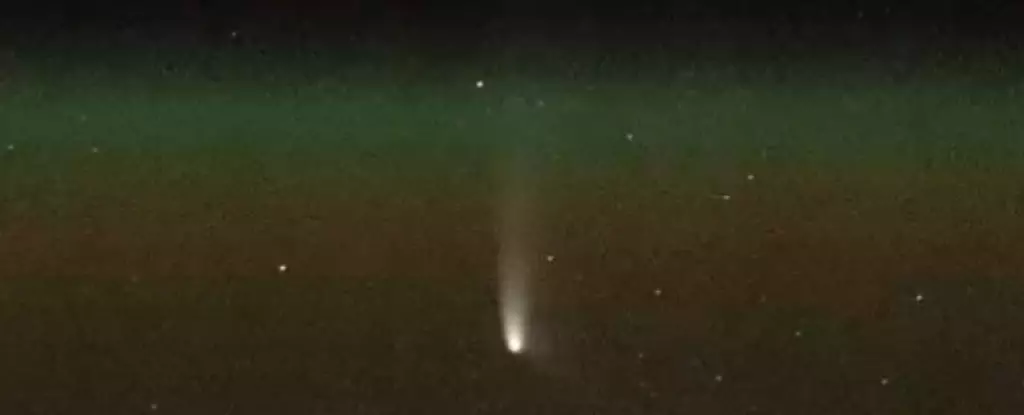In January 2023, astronomers captured the attention of stargazers worldwide with the discovery of a new comet, designated C/2023 A3 (Tsuchinshan-ATLAS). Comets frequently grace our skies, but this particular one sparked fervent speculation about its potential luminosity, with some enthusiasts dubbing it the “comet of the century.” Such bold claims must be tempered with caution, as predicting the brightness of comets is notoriously elusive. Historically, comet enthusiasts have learned that they must wait patiently for these celestial bodies to reveal their true nature.
As the anticipated moment draws closer, Comet C/2023 A3 has started to make its presence known. Currently visible without the aid of telescopes or binoculars in the pristine morning skies of Australia and Aotearoa New Zealand, the comet is expected to shine even brighter in the weeks ahead. Although it may not hold the title of “comet of the decade,” it stands a good chance of being crowned the best comet of 2023.
As of now, Comet C/2023 A3 appears much like a fuzzy star—a result of its growing brightness—as it rises ahead of dawn. To catch a glimpse of this comet, observers need to direct their gaze toward the eastern horizon. With the aid of binoculars, it becomes easier to discern its dusty tail stretching away from the Sun, adding to the cosmic wonder. The comet’s altitude in the morning sky will remain relatively stable until late September when its position will drop closer to the horizon, eventually fading from visibility as it becomes engulfed in the early dawn light.
Timing is essential for those interested in observing this extraordinary visitor. The comet reaches its perihelion, or closest proximity to the Sun, on September 27, drawing much closer—approximately 58 million kilometers away from our solar beacon. Following this point, Comet C/2023 A3 will edge nearer to Earth, which should contribute to its gradual brightening, culminating in an optimal viewing window around the end of September and the early days of October.
One of the most thrilling aspects of Comet C/2023 A3’s journey comes when it transits between the Earth and the Sun on October 9 and 10. This rarified moment could lead to a remarkable brightening effect generated by “forward scattering,” a phenomenon occurring when particles in the comet’s dust cloud scatter sunlight back towards our line of sight. If the conditions align favorably and the comet is sufficiently dusty, it may become bright enough to potentially see in daylight—an exhilarating prospect for avid astronomers, though visibility will be exceptionally challenging amid the proximity of the Sun.
For the discerning observer, viewing the comet during this phase will necessitate a specialized approach, as direct gazes at the Sun are ill-advised. As the comet moves past this exhilarating highlight, it will transition to a more favorable viewing position in the evening sky. Starting around October 12, it will rise higher and become a prominent feature for a few days, benefitting from the scattering effect before gradually trailing off in brilliance.
A Photographic Dream and the Nature of Comets
As the comet meanders through the solar system and climbs higher in the evening sky, photographers and stargazers alike will find ample opportunities to capture its serenity. Its tail may stretch beautifully across the night sky, though parts may be dim and elusive to naked-eye visibility. The middle of October promises to see a cascade of spectacular comet imagery flooding the digital landscape, with enthusiasts eager to share their views.
However, like any celestial event, the glimmering comet’s journey is fraught with unpredictability. While it currently exhibits predictable brightening patterns, comets are famously capricious. Historical occurrences remind us that hyperactive comets can break apart, sowing clouds of dust and gas into space. Such fragmentation could lead to even more captivating moments in the night sky, should it materialize.
Conversely, the comet could fail to illuminate as brightly as anticipated, leaving observers disappointed. Nevertheless, for now, the C/2023 A3 (Tsuchinshan-ATLAS) is living up to expectations and maintaining a crucial place in our astronomical observations.
A Lasting Impression Before Departure
As we approach the end of October, anticipation builds. Comet C/2023 A3 (Tsuchinshan-ATLAS) will soon exit the inner solar system, disappearing into the cosmic vastness. However, even as it fades from sight, it leaves behind a legacy worth celebrating for star enthusiasts everywhere. The comet might just tag its name onto the “comet of the year” mantle, making its mark well beyond its fleeting appearances.
With comet observations on the rise, all eyes will be glued to the sky hoping for a dazzling show. Time will tell how this celestial journey unfolds, but for now, enthusiasts remain engaged in the excitement these adventures in the cosmos bring to our lives.


Leave a Reply